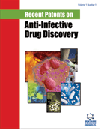Recent Patents on Anti-Infective Drug Discovery - Current Issue
Volume 16, Issue 1, 2021
-
-
Fecal Microbiota Transplant: Latest Addition to Arsenal against Recurrent Clostridium difficile Infection
More LessAn infectious disease of the colon, recurrent Clostridium difficile infection (RCDI), is hitherto considered insurmountable leading to significant morbidity and mortality. Gut dysbiosis, generally resulting from frequent use of antibiotics, is considered to be responsible for the etiopathogenesis of RCDI. Ironically, the conventional treatment strategies for the disease also include the use of anti- infective drugs such as metronidaz Read More
-
-
-
Exploring the Potentials of Corn Fiber Gum in Fabricating Mucoadhesive Floating Tablet of Poorly Gastro-retainable Drug
More LessAuthors: Bhumika Mangla, Anurekha Jain and Deepinder S. MalikAim: To formulate and preliminary evaluated polysaccharide based mucoadhesive floating tablets of Cinnarizine. Background: Gastro-retentive drug delivery systems has proved to be a successful approach to enhance the gastric residence with site specific targeting for achieving local or generalized effect. Various patents has also been filed globally employing gastro-retentive approach. Objective: The study is designed to Read More
-
-
-
Oleic Acid Vesicles as a New Approach for Transdermal Delivery of Econazole Nitrate: Development, Characterization, and In-vivo Evaluation in Wistar Rats
More LessAuthors: Shivani Verma and Puneet UtrejaBackground: Cutaneous candidiasis is a deep-seated skin fungal infection that is most commonly observed in immunocompromised patients. This fungal infection is conventionally treated with various formulations like gels and creams which are having different side effects and the least therapeutic efficacy. Hence, it becomes necessary to develop a novel carrier system for the treatment of this deep-seated skin fungal in Read More
-
-
-
Secondary Metabolites of Endophytic Fungi from Newbouldia laevis and Cassia tora Leaves: Prospecting for New Antimicrobial Agents
More LessAim: This study tries to find new antimicrobial agents using some Nigerian plants. Background: Antimicrobial compounds from fungi endophytes have shown great promise in mitigating the threats of resistant pathogens. Objective: The study evaluated the in vitro antimicrobial property of secondary metabolites of endophytic fungi isolated from Newbouldia laevis and Cassia tora leaves. Methods: Ten endophytic fungi were i Read More
-
-
-
The Staphylococcal Cassette Chromosome mec (SCCmec) Analysis and Biofilm Formation of Methicillin-resistant Staphylococcus cohnii Isolated from Clinical Samples in Tehran, Iran
More LessAuthors: Somayeh Delfani, Faranak Rezaei, Setareh Soroush and Pegah ShakibBackground: Methicillin-resistant coagulase-negative staphylococci is responsible for hospital and community-acquired infections. Objective: This study aimed to investigate the antibiotic-resistance patterns, antibiotic-resistance genes, namely, ermA, ermB, ermC, blaZ, msrA, tetK, tetM, mup, and vanA, biofilm formation, and prevalence of different SCCmec types among the Staphylococcus cohnii strains isolated from clinical s Read More
-
-
-
Neurobrucellosis: A Case Report with an Unusual Presentation
More LessAuthors: Mostafa Meshref, Yara Amro and Mahmoud A. EbadaBackground: Brucellosis is a highly infectious multi-systemic zoonosis, and it is caused by Gram-negative bacteria, Brucella. Despite the low incidence of neurobrucellosis, it is the most dangerous consequence of brucellosis. Case Presentation: A 30-year-old Sudanese male patient presented to our hospital with a complaint of fever associated with confusion for three days. He had signs of meningeal irritation in the f Read More
-
-
-
Transmissibility and Epidemicity of COVID-19 in India: A Case Study
More LessAuthors: Bevish Jinila and Prayla S. ShyryBackground: The global outbreak of COVID-19 was first reported in Wuhan, China, in the late 2019. The origin of the infection is still unclear. Over time, it spread to 150 countries in the world, due to which, the World Health Organization (WHO) declared the infectious disease to be pandemic. Objective: COVID-19 transmitted to India due to the arrival of travelers from other countries. The transmissibility and epidemicity of COV Read More
-
Most Read This Month Most Read RSS feed
Article
content/journals/pri
Journal
10
5
false
en


